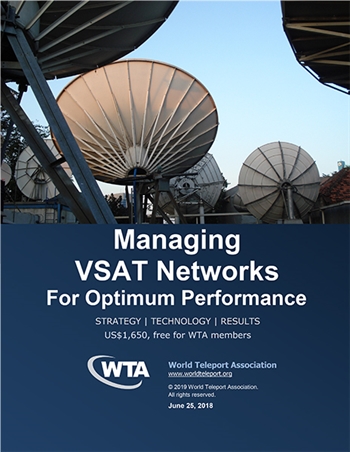Optimum Performance is the Only Performance
by Robert Bell
New York City, July 3, 2019--For a technology launched in the 1980s, VSATs have shown a remarkable ability to adapt and thrive. In fact, they are on a growth curve that, according to NSR, will create cumulative market revenue of $159 billion over the next decade. Maritime is forecast to lead the pack with a 16% CAGR to 75,000 VSAT-enabled vessels by 2028.
Growth is good. But it is rarely painless and nearly always comes with challenges for those trying to serve the growing market. Not least of which is trying to manage that growth while maintaining or even improving the bottom line.
That’s why WTA will soon publish a new report, Managing VSAT Networks for Optimum Performance. After speaking with teleport operators, satellite operators and technology providers, we are unpacking the challenges and how service providers and technologists are meeting them.
 The challenges are many. High (maybe unreasonable) customer expectations for quality of service, which demand higher levels of redundancy throughout the network. Customer demands for more for less money, which increases pressure on margins. More upstream traffic, driven by the explosion of video. And most of all, rising complexity as hundreds of terminals and applications become thousands.
The challenges are many. High (maybe unreasonable) customer expectations for quality of service, which demand higher levels of redundancy throughout the network. Customer demands for more for less money, which increases pressure on margins. More upstream traffic, driven by the explosion of video. And most of all, rising complexity as hundreds of terminals and applications become thousands.
Future-Proofing Your Networks
The experts we interviewed are intent on future-proofing networks to adapt to all these challenges – and do it profitably. They start with precision mapping of networks and terminals, merging that information with external maps, weather and the location of such interference sources as mobile antennas. Speaking of interference, there are great new technologies from companies like Kratos that reduce the long and tedious job of geolocation to a few mouse clicks.
Service providers are also having to accept the responsibility for end-to-end quality of service. It’s a big challenge to guarantee service across multiple networks, only some of which you control. But smart operators are finding ways to do it, from investing more in redundancy to new approaches for live monitoring.
Dealing with the Data Flood
The downside of all this hard and excellent work is the flood of data it produces. One contributor said that he is generating between five and six million data points from a single RF system covering up to 90 sites. Artificial intelligence offers the only possibility of making sense of it all, and there is a lot of progress in that area, as detailed in our recent report, Automating the Teleport.
In today’s competitive market, optimum performance is the only performance that customers will accept. Look for our publication announcement of Managing VSAT Networks for Optimum Performance next week. We thank Kratos for the financial support that made the report possible. Like all WTA reports, it is free for employees of member companies and available on a paid basis to all others.
-------------------------------------
.jpg) Robert Bell is Executive Director of the World Teleport Association, which represents the world’s most innovative teleport operators, carriers and technology providers in 46 nations. He can be reached at rbell@worldteleport.org Managing VSAT Networks for Optimum Performance it is free for employees of member companies and available on a paid basis to all others at the WTA website at: www.worldteleport.org.
Robert Bell is Executive Director of the World Teleport Association, which represents the world’s most innovative teleport operators, carriers and technology providers in 46 nations. He can be reached at rbell@worldteleport.org Managing VSAT Networks for Optimum Performance it is free for employees of member companies and available on a paid basis to all others at the WTA website at: www.worldteleport.org.





